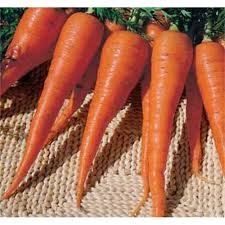GROWING CARROTS

GROWING CARROTS
Carrots, botanically classified Daucus carota have been grown in gardens for centuries. The Romans grew them, but they were not very popular until the Middle Ages. The earliest carrots had white, purple, red, or yellow roots. Orange colored carrots appeared as a mutation of yellow carrots during the seventeenth century. Some orange varieties from the 1800s have survived as heirlooms, but few of the old purple, red, yellow or white heirloom seed strains still exist. ‘Nantes Scarlet’ is a nineteenth century orange heirloom carrot still found in catalogs. ‘Round of Paris’ from 1881, is a very short, spherical orange carrot that tastes great and will grow fine in thin, stony soils. ‘St. Valery’ is another nineteenth century orange carrot that is sweet and tender, but it is a rare variety now. Orange carrots have been consistently popular since the 1800s, but recently the original colors have been rediscovered and are gaining in popularity. There are new seed strains available today in each of the separate colors, or you can purchase a mixture of all colors.
Most gardeners direct-seed carrots rather than starting them indoors. They grow quickly once germinated and do not transplant easily. Carrot seeds germinate between 45 and 85 degrees so you can try putting them in as early as April if your garden has been tilled and prepared in time. Full sun is the best location and a soil pH of 6.5 is ideal. Carrots like cool weather and can take mild frosts when up. The growing temperature range for carrots is 55–75 degrees (but 60-70 is best).
The germination time for Carrots varies from 7 to 21 days. It is helpful to mix the small carrot seed with sand for even distribution. Sow seed ½” apart, carefully, in rows about 16” apart, 1/4-1/2” deep. Baby carrots can be pulled and used as the plants left to grow large are thinned to 3 inches apart. Water the seedbed regularly; do not let the seedlings dry out. Be sure to weed the beds before the carrots emerge. Quite a few gardeners plant carrots in succession, every two weeks, to keep a steady supply ready.
Give your plants steady, even moisture. CARROTS NEED REGULAR WATERING!
A few pests that bother carrots are gophers, carrot root flies, aphids, blister beetles, carrot weevils and wireworms.
Harvest mature carrots when they are large enough to be sweet and are less than 1” in diameter. Dig carefully so as to not damage roots. Cut tops to less than 1”. Carefully wash the roots clean. To store them until used, keep them cool, in high humidity, and out of the sun. Place them in plastic bags to keep them moist.
Carrots can be left in the ground and harvested after frosts, and can be mulched heavily (at least one foot deep) with straw. You can brush the snow away and pull the carrots right up. Carrots do sweeten up in cooler weather, also. Voles will be troublesome in winter if carrots are left in and it might be better to harvest the roots and store them in damp sand in a cellar, or an underground cage filled with sand, or other protected place where they will not freeze, but stay moist and be free from predation.
